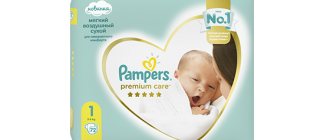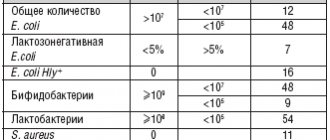Co-author, editor and medical expert - Dmitry Dmitrievich Volosov.
Number of views: 213 483
Last updated: 02/16/2022
Average reading time: 8 minutes
Breast milk allows the baby to receive all the nutrients necessary for its growth and full development, and relieves the mother from worrying about the correct selection of milk formulas, the temperature of the prepared baby food, etc. But there is a nuance in breastfeeding: the quality of the baby’s digestion directly depends on the mother’s diet . Therefore, quite often women turn to the doctor with the question of what to eat for the mother if the child is constipated, and how to normalize the newborn’s stool by correcting the mother’s diet.
Classification of constipation in newborns and infants
Stool retention in children can have an acute and chronic course. In the first case, it occurs once or is observed periodically, but with long intervals between episodes. In a chronic condition, this problem is relevant over a long period: symptoms of constipation are observed continuously over several weeks or months.
In addition to classification according to the course, constipation is divided into atonic and spastic. In the first case, peristalsis is sluggish and weak, and the excreted feces are dense and voluminous. With spastic constipation, excessive peristalsis is observed in one part of the intestine, which leads to temporary “blocking” of feces and its difficult movement. Feces with spastic constipation are heterogeneous, divided into small, dry and hard lumps.
Up to contents
Causes of constipation in infants
The most common causes of constipation in infants are the following:
- Maternal malnutrition.
Maternal nutrition for constipation in a breastfed infant should be considered first. It is the mother’s diet disorders that often lead to stool retention in the child. The diet of a nursing mother for constipation in a baby often includes foods that have a strengthening property. - Features of the nervous system of a newborn.
A kind of immaturity of the mechanisms responsible for the innervation (that is, the supply of organs and tissues with nerves, ensuring their connection with the central nervous system) of the intestine can cause constipation due to an insufficient response of receptors to irritation by feces. - Taking medications by the mother.
A number of medications necessary for the treatment of various diseases and conditions in a nursing mother have side effects in the form of decreased intestinal tone, slower peristalsis, etc. Therefore, when prescribing drug therapy, a woman should inform the doctor that she is breastfeeding.
Up to contents
Nutrition for a nursing mother. Word to the allergist
How is breast milk created?
Mother's milk is a unique creation of living nature. This is nutrition that is created by your body specifically for your child, as if it were the most personalized therapy. Mother's milk is exactly the product that her baby needs at all stages of its development until it outgrows this need. Breast milk is produced by special glandular cells in the breast, they specialize only in the production of milk and colostrum. Nutrients, vitamins, biologically active substances, trace elements and beneficial bacteria enter the glandular cells of the mammary gland from the blood and lymph. And there, in turn, from the internal resources of the body and from food. Food travels a long way to the mammary gland: the oral cavity, esophagus, stomach and intestines, where food is absorbed and digested, then the blood enters the liver, where it is “purified” and then goes to the mammary glands. Some nutrients, especially fats, circulate mostly in the lymph. And from the lymphatic system they enter the mammary glands. Thus, substances from food do not pass directly from the intestines into breast milk. They travel a long way and the secretion of substances from food into breast milk is quite individual and unpredictable.
So, a study was conducted where nursing mothers ate chicken eggs, and then the presence of chicken egg protein in breast milk was checked. It turned out that a quarter of women do not excrete chicken egg white into milk at all for some reason! This may be a surprising fact, given the belief that all products that enter the mother's body through food immediately end up in milk.
Can breast milk be “empty”, “bad”?
Breast milk is always the best for your baby, no matter what you eat or don't eat. Its composition changes little depending on the presence or absence of any foods in your diet. But if you do not get enough nutrients, vitamins and minerals from food, then these substances will enter the milk at the expense of your body. Therefore, we can immediately say: for the nursing mother, for the sake of, first of all, her own
health, you should eat well. In fairly rare cases, a child is allergic to some food protein, and if this protein is present in the mother's milk, it can cause some symptoms in the baby until it is excluded from the mother's diet. However, there cannot be an allergy to the components of breast milk itself, to human proteins! They are neutral for the child's body.
Allergies and breastfeeding. How are they connected?
Food allergies
- This is a fairly rare condition, both among children and adults and occurs in only 2-5% of the entire population. Often food allergies are diagnosed where none exist, and the mother is recommended to go on a strict diet for a long time. Let's figure out how allergies in a breastfed baby can depend on his mother's diet.
Allergen
– this is a foreign protein. With food, the protein enters the bloodstream and is carried throughout the body, including in some quantities penetrating into breast milk. Most often, allergies in children are caused by cow's milk protein, chicken egg protein, and much less often by wheat, soy, fish, seafood, nuts, and peanuts. These are the so-called “big eight” allergens. There is an assumption that human ancestors were not adapted for such a mass culture of farming and agriculture, as well as the fishing industry. Therefore, a diet consisting of 90% dairy products, bread and other wheat products, eggs, and in some regions of the world soy, rice, fish and seafood has led to such a frequency of sensitization (increased sensitivity) of people to these foreign proteins.
Pseudo-allergy.
Histamine liberators are foods that, without the participation of the immune system, can increase histamine levels or themselves contain a lot of histamine. Reactions to them are dose-dependent, not dangerous and pass quickly (temporary redness, slight itching). Histamine liberators include red fruits, vegetables, berries, citrus fruits, cocoa, chocolate, red wine, fermented cheeses, smoked meats and marinades, smoked fish, red fish, caviar, honey. It is absolutely not necessary for all nursing mothers to exclude them from the diet.
Allergic reaction
appears
immediately
(maximum within 1-2 days for delayed reactions such as gastrointestinal reactions and exacerbation of atopic dermatitis). A typical allergy is Quincke's edema, urticaria immediately after consuming the product.
Allergies cannot accumulate and cannot be hidden. This is a reaction.
Either a person has an allergy or he doesn’t. If it exists, then it manifests itself under any conditions upon contact with an allergen. Even the presence of IgE antibodies in the blood does not mean for sure that a person will have a reaction to this allergen, he just has antibodies.
An allergy is not a specific rash.
It is impossible to simply glance at a person and without learning anything about his life history and illness to say that he has an allergy. An allergist, like Sherlock Holmes, looks for an allergen using leading questions and sometimes tests and analyses. It is not only the external manifestation that is important, but also a clear symptom-allergen connection, reproducible and repeatable. Manifestations of food allergies in infants can include not only skin rashes, but also significant stool disorders, streaks of blood in the stool, excessive regurgitation, and poor weight gain. Skin rashes are very important not to be confused with other skin conditions, such as diaper rash, prickly heat, diaper dermatitis, dry skin, atopic dermatitis, viral rashes, transient erythema in newborns, neonatal acne, etc.
Allergic diseases
are not inherited, only the predisposition to them is passed on.
Such a common disease as atopic dermatitis is not always
associated with food allergies. It often happens that only the state of the damaged skin barrier plays a big role here.
Basic facts of modern allergology regarding food allergies in children.
Variety is everything!
Modern scientific research has proven that a hypoallergenic diet
during pregnancy and lactation
does not reduce the risk of
developing allergies in the child. On the contrary, deliberate exclusion of all potentially allergenic foods from a pregnant and lactating woman's diet increases the risk of allergies because tolerance (tolerance) to these foods cannot be developed. The child’s body must gradually become familiar with all products in order to learn to build its barriers and react correctly to foreign substances. For the mother’s body after childbirth, it is very important to eat well, including vegetables, fruits, nuts, and fish!
Find and neutralize the allergen!
an unusual, strong immediate reaction in your child
on some product in your diet, then exclude this product for now, contact a breastfeeding-friendly pediatrician or allergist. The doctor will ask you to follow a diet for some time with the exclusion of the intended product (elimination diet), and do allergy tests.
1) For atopic dermatitis, an elimination diet is prescribed for no more than 2-4 weeks
! If there is no improvement, the product is administered again. Under no circumstances should you be on a strict diet with the exclusion of many foods important for the body for more than 4 weeks!
2) There is never a need to stop breastfeeding!
Just exclude the found allergen/new ones from the diet. Breast milk is always better than any formula, even for various allergic conditions. If you are asked to stop breastfeeding, consult another specialist.
3) Exclude from your diet only those foods that you yourself
there is an allergic reaction. This is a clear and obvious fact. But the same allergies as mom or dad, for example, to cats or nuts, are not so strictly transmitted to the child. A child may not have any allergy at all or may develop an allergy to birch pollen. Everything is individual.
So, regarding allergies and breastfeeding, we can say the following: a nursing mother needs to eat a nutritious and varied diet. Even if you are at risk of developing allergic diseases, you do not need to limit yourself to a hypoallergenic diet. If a doctor proves an allergic reaction to any product, then it is excluded from the mother’s diet for 6 to 24 months. The duration of the elimination diet is determined by the doctor. Then the product is tried again. Most often, babies are allergic to the protein of cow's milk and chicken eggs. Allergies to these products usually go away with age and tolerance develops. Canceling breastfeeding for allergic diseases is not required.
Should a nursing mother eat for two?
No, that's unnecessary. The “production” of breast milk requires 400-500 calories more than usual. Moreover, the body can use these calories from reserves accumulated during pregnancy. Breastfeeding helps you lose weight! Therefore, a nursing mother needs to eat according to her appetite, preferably more often, in small portions. Snacks are allowed.
Colic is caused by cabbage, peas and other foods in the mother's diet. Is it so?
There is currently no reliable evidence that certain foods cause increased gas formation in a baby. Therefore, excluding cabbage, fresh vegetables and fruits and other products from the diet for which mother or grandmother “fears” is completely unnecessary. Of course, if these foods cause bloating in the nursing mother herself, then there is no need to consume them. But they are unlikely to have any effect on the child. Most children from 3 weeks to 3 months experience colic, and this in no way depends on the mother’s diet. Most likely, this is some kind of migraine in children (perhaps the baby just has a severe headache or tummy ache). You need to try to introduce a protective regime: warmth, silence, darkness and breastfeeding in the evening in the dark in order to convey the sleep hormone melatonin to the baby. Time and love help with colic, but not a strict diet.
The baby's gastrointestinal system is still developing, so there may be gas and a bloated tummy. Foamy, abundant stools with greens most often indicate transient lactase deficiency, which is easily overcome by breastfeeding or, in extreme cases, by adding the lactase enzyme for a while. To do this, contact a breastfeeding-friendly pediatrician and breastfeeding consultant. Bloating, gas, colic, if the child develops normally and gains weight, does not require the mother to diet, much less stop breastfeeding or prescribe antibacterial drugs.
Can a nursing mother eat sweets and spices?
Like any non-lactating or non-pregnant woman, a nursing mother can eat sweets, but it is better not to abuse simple carbohydrates and include dried fruits and nuts in your diet. Not to overindulge means: not eating two bars of chocolate or ten buns in one sitting. This will have an adverse effect on your figure and metabolism. And drinking tea with cookies or a slice of chocolate is quite possible and necessary. As for spices, onions and garlic: they do not have a bad effect on the baby’s health. A small amount of them even slightly changes the taste of breast milk. But it is useful for the baby to get used to the traditional tastes of his culture through milk. So, in our country it can be fried potatoes with garlic and pickled cucumber, and in India it can be curry and other spices.
Can a nursing mother drink alcohol and coffee?
Coffee is preferably no more than 200 mg of caffeine per day. This is about 2 cups of strong coffee or 3-4 weak coffee with milk. The risk of an allergy to coffee is minimal, but caffeine can pass into breast milk in large quantities and affect the baby’s nervous system. Alcohol in moderate doses and occasionally is acceptable during breastfeeding. There is no need to express milk after a glass of wine. After 2-3 hours, the ethyl alcohol itself will leave the breast milk and you can feed the baby.
Dear nursing mothers, eat varied and with pleasure! A happy and healthy mother has a happy baby! Delicious milk everyone!
Author of the article: pediatrician, allergist, breastfeeding and sleep consultant Yulia Bunina
List of used literature (research):
Ø Francesca Bravi, Frank Wiens, Adriano Decarli, Alessia Dal Pont, Carlo Agostoni, Monica Ferraroni, Impact of maternal nutrition on breast-milk composition: a systematic review, The American Journal of Clinical Nutrition
, Volume 104, Issue 3, September 2016, Pages 646–662,
Ø EAACI Food allergy and anaphylaxis guidelines 2014
Ø Susana Ares Segura, José Arena Ansótegui, N. Marta Díaz-Gómez, La importancia de la nutrición materna durante la lactancia, ¿necesitan las madres lactantes suplementos nutricionales?,Anales de Pediatría, Volume 84, Issue 6,2016
Ø Federica Minniti, Pasquale Comberiati, Daniel Munblit, Giorgio L. Piacentini, Elisa Antoniazzi, Laura Zanoni, Attilio L. Boner and Diego G. Peroni, “Breast-Milk Characteristics Protecting Against Allergy”, Endocrine, Metabolic & Immune Disorders - Drug Targets (2014) 14:9.
Ø Ventura A, K: Does Breastfeeding Shape Food Preferences Links to Obesity. Ann Nutr Metab 2017;70(suppl 3):8-15.
Ø Joanne M Spahn, Emily H Callahan, Maureen K Spill, Yat Ping Wong, Sara E Benjamin-Neelon, Leann Birch, Maureen M Black, John T Cook, Myles S Faith, Julie A Mennella, Kellie O Casavale, Influence of maternal diet on flavor transfer to amniotic fluid and breast milk and children's responses: a systematic review, The American Journal of Clinical Nutrition
, Volume 109, Issue Supplement_1, March 2022, Pages 1003S–1026S,
Ø Metcalfe, JR, Marsh, JA, D'Vaz, N., Geddes, DT, Lai, CT, Prescott, SL and Palmer, DJ, Clinical & Experimental Allergy
, 2016 ( 46) 1605– 1613.
Ø Amy A. Gelfand, Infant Colic, Seminars in Pediatric Neurology, Volume 23, Issue 1, 2016, Pages 79-82
Ø Wollenberg, A. , Barbarot, S. , Bieber, T. , Christen-Zaech, S. , Deleuran, M. , Fink-Wagner, A. , Gieler, U. , Girolomoni, G. , Lau, S. , Muraro, A. , Czarnecka-Operacz, M. , Schäfer, T. , Schmid-Grendelmeier, P. , Simon, D. , Szalai, Z. , Szepietowski, J. , Taïeb, A. , Torrelo, A. , Werfel , T. , Ring, J. and , (2018), Consensus‐based European guidelines for the treatment of atopic eczema (atopic dermatitis) in adults and children: part I. J Eur Acad Dermatol Venereol, 32: 657–682.
Ø J MURUGU SARASU, MANISH NARANG AND DHEERAJ SHAH. Infantile Colic: An Update. Indian Pediatr 2022 Nov
Ø Oddy W, H: Breastfeeding, Childhood Asthma, and Allergic Disease. Ann Nutr Metab 2017;70(suppl 2):26-36.
Ø Blanchard, Carine. A history into genetic and epigenetic evolution of food tolerance: how humanity rapidly evolved by drinking milk and eating wheat. Current Opinion in Allergy and Clinical Immunology: December 2022 – Volume 17 – Issue 6 – p 460–464
Ø Maternal diet during pregnancy and lactation and cow's milk allergy in offspring. J Tuokkola, P Luukkainen, H Tapanainen, M Kaila, O Vaarala, MG Kenward, LJ Virta, R Veijola, O Simell, J Ilonen, M Knip & SM Virtanen. European Journal of Clinical Nutrition volume 70, pages 554–559 (2016)
Ø Metcalfe, JR, Marsh, JA, D'Vaz, N., Geddes, DT, Lai, CT, Prescott, SL and Palmer, DJ, Effects of maternal dietary egg intake during early lactation on human milk ovalbumin concentration: a randomized controlled trial. Clinical & Experimental Allergy, 2016 (46) 1605–1613.
Ø Importance of maternal diet in the training of the infant's immune system during gestation and lactation. P. V. Jeurink, K. Knipping, F. Wiens, K. Barańska, B. Stahl, J. Garssen. Critical Reviews in Food Science and Nutrition. Volume 59, 2022 – Issue 8Pages 1311-1319
Ø Palmer, DJ, Gold, MS and Makrides, M. (2008), Effect of maternal egg consumption on breast milk ovalbumin concentration. Clinical & Experimental Allergy, 38: 1186–1191.
Ø Jessica H. Savage, Kathleen A. Lee-Sarwar, Joanne E. Sordillo, Nancy E. Lange, Yanjiao Zhou, George T. O'Connor, Megan Sandel, Leonard B. Bacharier, Robert Zeiger, Erica Sodergren, George M. Weinstock, Diane R. Gold, Scott T. Weiss, Augusto A. Litonjua, Diet during Pregnancy and Infancy and the Infant Intestinal Microbiome, The Journal of Pediatrics, Volume 203, 2022, Pages 47-54.e4,
Ø Detection of β-lactoglobulin in human breast-milk 7 days after cow milk ingestion. Ponpan Matangkasombut, Savitree Padungpak, Sasikanya Thaloengsok, Wasu Kamchaisatian, Cherapat Sasisakulporn, Wanlapa Jotikasthira,. Paediatrics and International Child Health Volume 37, 2022 – Issue 3 Pages 199-203
Ø Zhu J, Garrigues L, Van den Toorn H, Stahl B, Heck AJR. Discovery and Quantification of Nonhuman Proteins in Human Milk. J Proteome Res. 2019;18(1)
The importance of maternal nutrition for constipation in an infant
The nutrition of a nursing mother during constipation in a child is much more important than it might seem at first glance. Thus, a lack of fluid in the diet leads to an increase in the fat content of milk, which can cause stool retention in a child. Consuming large amounts of sweets and baked goods can change the chemical composition of milk. This also negatively affects the baby’s intestinal functions. And the absence of plant-based products in the menu - vegetables and fruits, vegetable oils, etc. - reduces the amount of vitamins and microelements in breast milk, which can cause not only constipation, but also other medical problems.
Up to contents
Sources of flatulence development
A normally functioning body of a healthy person produces 0.5-2 thousand ml of gas daily. It includes:
- nitrogen;
- hydrogen;
- oxygen;
- methane;
- hydrogen sulfide;
- carbon dioxide.
The appearance of alimentary flatulence is associated with several reasons:
- high content of plant fiber and starch in food products;
- carbonated drinks;
- dishes that cause fermentation processes;
- insufficient amount of enzymes;
- impaired absorption of gases;
- dysbacteriosis;
- dysfunction of digestive processes;
- lactose intolerance (cow's milk).
Flatulence, a mechanical form, occurs:
- for polyps;
- tumors;
- impaired peristalsis with slow removal of excess air;
- toxic effects of various infections.
Circulatory flatulence is provoked by changes in intestinal motility and disturbances in evacuation function. The reason for the high-altitude form is a sharp rise to altitude with a strong expansion of gases and an increase in their pressure. Psychogenic flatulence is a consequence of mental illness.
Recommended Products
What a nursing mother should eat for constipation can be chosen from the list of recommended foods:
- Cereals
. Wheat, oatmeal, corn, buckwheat porridge, whole grain bread, wholemeal or bran bread. - Meat products.
All varieties of lean meat boiled, baked or stewed, soups in weak broths. - Vegetables
. Table beets, pumpkin, zucchini, cucumbers, cabbage, potatoes, tomatoes in the form of salads from fresh or boiled vegetables, side dishes, independent dishes (soups, stews, casseroles, etc.). - Dried fruits
. Dried apricots and prunes are the best foods with a laxative effect, but their consumption should be limited to 3-5 pieces. per day, as they can cause diarrhea if consumed in excess.
Up to contents
Not recommended products
The presence in the diet of foods with a laxative effect and rich in fiber is not the only condition that a diet requires for constipation in infants. It is equally important to exclude from the maternal menu products that produce a fixing effect. These include rice, semolina, pasta, baked goods, sweets, pears, pomegranates, strong brewed tea, coffee, cocoa, chocolate.
If constipation in a baby is accompanied by intestinal colic and increased gas formation, all legumes should also be excluded from the diet, and vegetables and fruits from the recommended list should be consumed only in processed form (soups, purees, stews, etc.). Laxative products during breastfeeding should also be limited if the child has unstable stools - alternating constipation and diarrhea.
Up to contents
Rules for maternal nutrition and child feeding to avoid constipation
Maternal nutrition for constipation in infants is of great importance. But diet and hygiene are no less important: they help eliminate a number of factors that have an undesirable effect on the mother’s body and, as a result, on the quality of breast milk.
Observe eating and feeding times
. A clear regimen will make mother’s digestion more efficient and, accordingly, improve the absorption of nutrients. And eating small portions 4-5 times a day will ensure an even supply of nutrients to the milk. Feeding the baby should be based on the same principle. Accustom him to eating at strictly designated hours according to his age - a “disciplined” digestive system is much less prone to constipation.
Maintain good feeding hygiene
. In addition to traditional hygiene procedures before feeding (washing hands, wiping the nipple and areola), it is necessary to ensure that the child grasps the nipple correctly. When sucking movements, he should not swallow air - this can cause disturbances in the gastrointestinal tract. To ensure better hygiene and to make mom feel more confident during breastfeeding, we recommend using JOHNSON'S® Baby breast pads.
MICROLAX® has prepared visual material especially for mothers of babies prone to constipation:
Up to contents
Diagnostic procedures
When visiting a local clinic, the patient is referred for a consultation with a gastroenterologist. The doctor conducts a standard survey to clarify the symptoms of the pathology and study the medical history. Determination of the causes of non-standard functioning of the gastrointestinal tract is carried out using x-ray examination.
The auscultation technique, based on the study of noise in the intestinal tract, helps to identify the presence of a dynamic or mechanical form of the disease. The remaining procedures are prescribed according to the type of gastrointestinal disease that causes massive gas formation.










